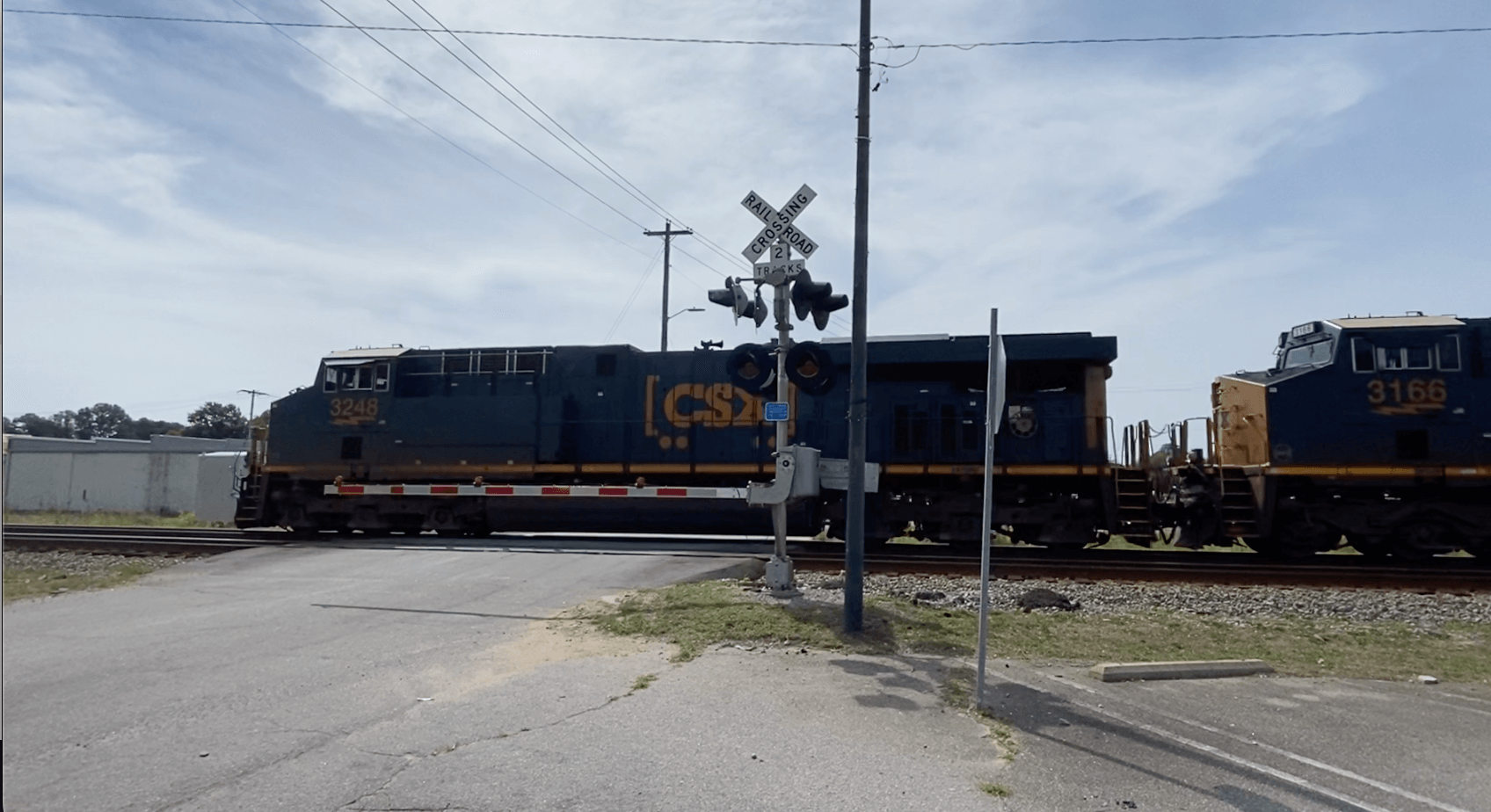
A freight train runs through the middle of downtown Enfield, North Carolina in June. (Photo by Michael McElroy, Cardinal & Pine)
North Carolina is a major corridor for freight lines, and a strike would have made existing supply-line disruptions even worse across the state and nationally.
A big, BIG rail strike was temporarily averted in the early morning hours Thursday after the rail companies finally agreed to concessions regarding punishing attendance and time-off policies.
Maybe you’ve only heard about the potential rail strike in the context of how bad it would have been for the US economy or railroad companies’ bottom line. But that’s only half the argument.
Rail workers say their treatment by their bosses has been so deplorable, they can’t even take time off to go to a doctor’s appointment without getting potentially suspended or fired. Rail companies had refused to budge on those policies.
But after a marathon 20-hour session Wednesday into Thursday, rail companies and union negotiators reached a tentative agreement, Labor Secretary Marty Walsh announced just after 4 a.m. Thursday.
North Carolina is a major corridor for freight lines, and a strike would have made existing supply-line disruptions even worse across the state and nationally.
Though Amtrak passenger trains were not part of the negotiations, they still use many freight lines, and would been unable to run on them during a strike. Before the deal was announced, Amtrak canceled many Southern routes this weekend, including several in North Carolina, in anticipation of a strike. After the deal, Amtrak said it would work to restore its regular schedule.
That agreement, according to the presidents of the Brotherhood of Locomotive Engineers and Trainmen (BLET) union and the Transportation Division of the International Association of Sheet Metal, Air, Rail, Transportation (SMART-TD) union, includes the following:
- An immediate wage increase of 14%, plus 4% and 4.5% increases in 2023 and 2024.
- Retroactive wage increases of 3% in 2020, 3.5% in 2021 and 7% in 2022.
- Annual lump sum bonus payments
- No increases to health care copays or deductibles or disruptions to workers’ existing network of doctors
- Voluntary assigned days off for freight service members and one additional paid day off for all members
- Ability to take time off for routine and preventative health care visits
- Exemptions to the attendance policy for hospitalizations and surgery
- Two-person crews “for the indefinite future,” instead of fast-tracking a one-person crew policy carriers wanted
“The solidarity shown by our members, essential workers to this economy who keep America’s freight trains moving, made the difference,” SMART-TD President Jeremy Ferguson and BLET President Dennis Pierce, said in a joint statement.
Both thanked the Biden administration, Walsh, and his deputy labor secretary, and thanked congressional leaders “who listened to our requests and stayed out of our dispute, allowing for an agreement to be reached across the bargaining table, rather than through legislation.”
The deal was “an important win for our economy and the American people,” President Joe Biden said in a statement Thursday. “It is a win for tens of thousands of rail workers who worked tirelessly through the pandemic.
“I thank the unions and rail companies for negotiating in good faith and reaching a tentative agreement that will keep our critical rail system working and avoid disruption of our economy,” Biden continued.
But the agreement isn’t a contract. For that to happen, those tens of thousands of workers need to vote to ratify it.
And it’s far from clear that’s a foregone conclusion.
Many on Twitter said the fact that workers hadn’t yet seen the full details of the tentative agreement. Others said measures on time off and attendance didn’t go far enough.
Still, others noted the International Association of Machinists and Aerospace Workers (IAM), which represents about 6,600 workers, or 5% of the unionized rail workforce, voted down a previous agreement. They could strike as early as Sept. 29, which would likely lead the other rail unions to follow suit.
Others caution that their local members haven’t actually seen the full tentative agreement yet, and are reacting instead to news articles and social media posts.
“You always fear membership (hearing) disinformation,” said Christopher Walker, the SMART-TD Iowa State Legislative Director. “It’s a lot harder to get the real information out there.”
Walker said he expects to see that agreement either Thursday night or Friday, saying he would “hate to jump to conclusions” until then. Members will then have several days to look it over themselves.
“Hopefully, if it’s a worthy contract, the membership will ratify it and we can keep moving forward,” he added.
(Michael McElroy of Cardinal & Pine contributed reporting.)
Politics

Emergency rooms refused to treat pregnant women, leaving one to miscarry in a lobby restroom
By AMANDA SEITZ Associated Press WASHINGTON (AP) — One woman miscarried in the lobby restroom of a Texas emergency room as front desk staff refused...

‘Unfit to be our next governor’: NC basketball greats speak out against Mark Robinson’s run for governor
NC has a long history of greatness on the basketball court. Now college basketball players from UNC, NC State, and Duke are wading into politics....
Local News

Good News Friday: It’s a good day to be a fan of the NC State Wolfpack
The men's and women's teams will compete for a national championship in college basketball this weekend. Plus: How to watch the solar eclipse, and...

The zodiac signs of 12 iconic women offer insight into their historic accomplishments
Zodiac signs can tell you a lot about someone’s personality. Whether they’re an earth, water, air, or fire sign, these 12 categories (which are...




